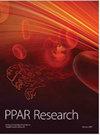The Expression of PPAR Pathway-Related Genes Can Better Predict the Prognosis of Patients with Colon Adenocarcinoma
IF 3.1
3区 医学
Q2 MEDICINE, RESEARCH & EXPERIMENTAL
引用次数: 3
Abstract
The postoperative survival time and quality of life of patients with colon adenocarcinoma (COAD) varies widely. In order to make accurate decisions after surgery, clinicians need to distinguish patients with different prognostic trends. However, we still lack effective methods to predict the prognosis of COAD patients. Accumulated evidences indicated that the inhibition of peroxisome proliferator-activated receptors (PPARs) and a portion of their target genes were associated with the development of COAD. Our study found that the expression of several PPAR pathway-related genes were linked to the prognosis of COAD patients. Therefore, we developed a scoring system (named PPAR-Riskscore) that can predict patients' outcomes. PPAR-Riskscore was constructed by univariate Cox regression based on the expression of 4 genes (NR1D1, ILK, TNFRSF1A, and REN) in tumor tissues. Compared to typical TNM grading systems, PPAR-Riskscore has better predictive accuracy and sensitivity. The reliability of the system was tested on six external validation datasets. Furthermore, PPAR-Riskscore was able to evaluate the immune cell infiltration and chemotherapy sensitivity of each tumor sample. We also combined PPAR-Riskscore and clinical features to create a nomogram with greater clinical utility. The nomogram can help clinicians make precise treatment decisions regarding the possible long-term survival of patients after surgery.PPAR通路相关基因的表达可以更好地预测结肠癌患者的预后
结肠癌(COAD)患者的术后生存时间和生活质量差异很大。为了在手术后做出准确的决定,临床医生需要区分具有不同预后趋势的患者。然而,我们仍然缺乏有效的方法来预测COAD患者的预后。积累的证据表明,过氧化物酶体增殖物激活受体(PPARs)及其部分靶基因的抑制与COAD的发生有关。我们的研究发现,几个PPAR通路相关基因的表达与COAD患者的预后有关。因此,我们开发了一个评分系统(名为PPAR-Riskscore),可以预测患者的预后。基于肿瘤组织中4个基因(NR1D1、ILK、TNFRSF1A和REN)的表达,通过单变量Cox回归构建PPAR-Riskscore。与典型的TNM分级系统相比,PPAR-Riskscore具有更好的预测准确性和敏感性。该系统的可靠性在六个外部验证数据集上进行了测试。此外,PPAR-Riskscore能够评估每个肿瘤样本的免疫细胞浸润和化疗敏感性。我们还将PPAR-Riskscore和临床特征相结合,创建了一个具有更大临床实用性的列线图。列线图可以帮助临床医生就患者手术后可能的长期生存做出准确的治疗决定。
本文章由计算机程序翻译,如有差异,请以英文原文为准。
求助全文
约1分钟内获得全文
求助全文
来源期刊

PPAR Research
MEDICINE, RESEARCH & EXPERIMENTAL-
CiteScore
6.20
自引率
3.40%
发文量
17
审稿时长
12 months
期刊介绍:
PPAR Research is a peer-reviewed, Open Access journal that publishes original research and review articles on advances in basic research focusing on mechanisms involved in the activation of peroxisome proliferator-activated receptors (PPARs), as well as their role in the regulation of cellular differentiation, development, energy homeostasis and metabolic function. The journal also welcomes preclinical and clinical trials of drugs that can modulate PPAR activity, with a view to treating chronic diseases and disorders such as dyslipidemia, diabetes, adipocyte differentiation, inflammation, cancer, lung diseases, neurodegenerative disorders, and obesity.
 求助内容:
求助内容: 应助结果提醒方式:
应助结果提醒方式:


